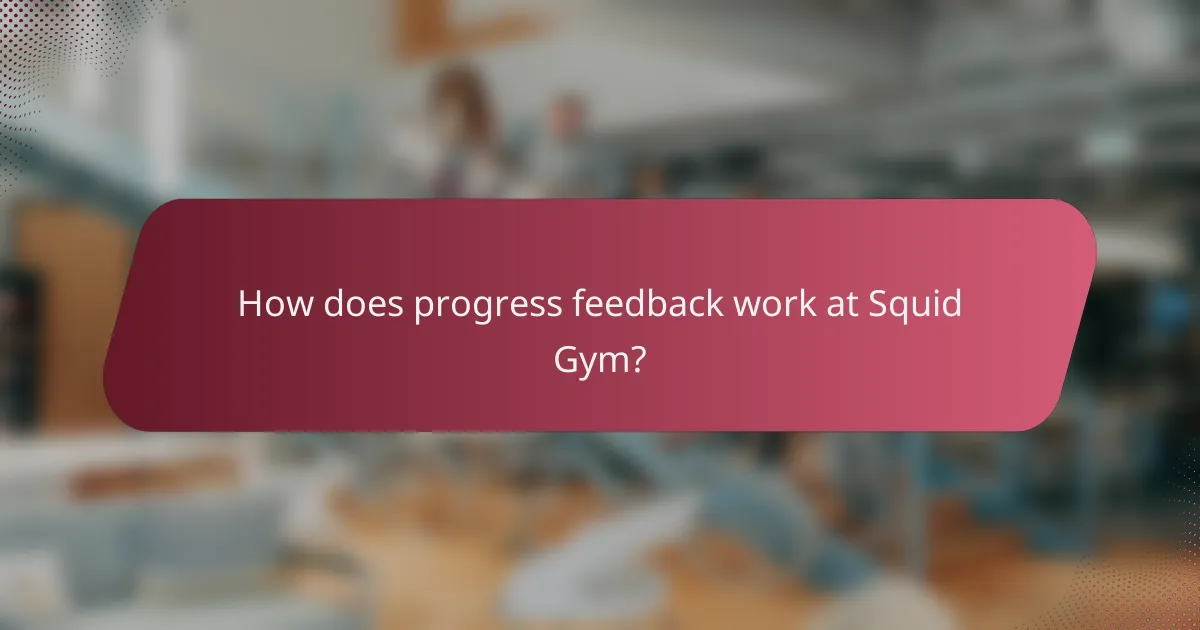At Squid Gym, effective goal adjustment strategies are essential for helping members stay motivated and aligned with their fitness aspirations. By setting clear objectives and regularly assessing progress, members can adapt their plans based on valuable feedback. Additionally, the gym provides various flexibility options, such as customizable membership plans and flexible class schedules, to accommodate diverse schedules and preferences, ensuring that everyone can commit to their fitness journey.

What are effective goal adjustment strategies at Squid Gym?
Effective goal adjustment strategies at Squid Gym involve setting clear objectives, regularly assessing progress, and adapting plans based on feedback. These strategies ensure that members stay motivated and aligned with their fitness aspirations.
SMART goal framework
The SMART goal framework is a practical approach to setting fitness objectives that are Specific, Measurable, Achievable, Relevant, and Time-bound. For example, instead of saying “I want to get fit,” a SMART goal would be “I will run 5 kilometers in under 30 minutes within three months.” This clarity helps members focus their efforts and track their progress effectively.
When using the SMART framework, it’s crucial to regularly revisit and adjust goals as needed. If a member finds a goal too easy or too challenging, they should modify it to maintain motivation and ensure continued progress.
Regular progress assessments
Regular progress assessments are vital for understanding how well members are meeting their fitness goals. Squid Gym recommends conducting these assessments every few weeks, allowing members to evaluate their performance and make necessary adjustments. This could involve tracking weight, measuring endurance, or noting improvements in strength.
Members should be encouraged to celebrate small victories during these assessments, as this can boost motivation. If progress stalls, it may be time to reassess goals or change training strategies to overcome plateaus.
Personalized training plans
Personalized training plans cater to individual fitness levels, preferences, and goals, making them more effective than generic programs. At Squid Gym, trainers work with members to develop tailored plans that consider their unique circumstances, such as time availability and fitness history.
These plans should be flexible and adaptable, allowing for changes based on progress assessments or personal feedback. Members are encouraged to communicate openly with trainers about what is working and what isn’t, ensuring the training remains relevant and engaging.
Incorporating member feedback
Incorporating member feedback is essential for refining training strategies and enhancing the overall gym experience. Squid Gym actively seeks input from its members through surveys and informal discussions, allowing them to voice their opinions on programs and facilities.
Feedback should be taken seriously and used to make adjustments that benefit the entire community. For instance, if multiple members express a desire for more group classes, the gym can consider adding new sessions to meet this demand, fostering a supportive environment that encourages participation and commitment.

How does progress feedback work at Squid Gym?
Progress feedback at Squid Gym is designed to help members track their fitness journey and make necessary adjustments to their goals. This system incorporates various methods to ensure that members receive timely and relevant information about their performance and progress.
Weekly performance reviews
Weekly performance reviews provide members with a structured opportunity to assess their progress. During these reviews, trainers evaluate workout data, discuss achievements, and identify areas for improvement. This feedback loop encourages accountability and helps members stay motivated.
Members can expect to receive insights on metrics such as workout intensity, frequency, and overall consistency. Setting specific targets for the upcoming week can enhance focus and drive results.
Use of fitness tracking apps
Fitness tracking apps play a crucial role in providing real-time data on workouts and progress. These applications allow members to log their exercises, monitor their calorie intake, and track other health metrics. Integration with wearable devices can further enhance the accuracy of this data.
Popular apps often include features such as goal-setting, reminders, and progress graphs. Members should choose an app that aligns with their fitness objectives and is user-friendly to ensure consistent usage.
Member accountability partnerships
Member accountability partnerships foster a sense of community and support among gym-goers. By pairing up with a workout buddy, members can motivate each other, share progress, and celebrate achievements together. This partnership can significantly enhance commitment to fitness goals.
To maximize the effectiveness of these partnerships, members should establish regular check-ins and set shared goals. This collaborative approach can help maintain enthusiasm and create a positive workout environment.

What flexibility options are available at Squid Gym?
Squid Gym offers various flexibility options to accommodate different schedules and preferences, making it easier for members to stay committed to their fitness goals. These options include flexible class schedules, drop-in sessions, and customizable membership plans, ensuring that everyone can find a suitable arrangement.
Flexible class schedules
Squid Gym provides a range of class schedules to fit diverse lifestyles. Classes are typically available throughout the day, including early morning, lunchtime, and evening slots, allowing members to choose times that align with their personal commitments.
When selecting a class, consider peak hours, as these may be busier and require advance booking. Off-peak classes often provide a more relaxed environment, which can enhance your workout experience.
Drop-in sessions
Drop-in sessions at Squid Gym allow members to participate in classes without a prior commitment. This option is ideal for those with unpredictable schedules or for individuals who want to try out different classes before committing to a regular slot.
Members can typically join drop-in sessions on a pay-per-class basis, which can range from a few dollars to around twenty USD, depending on the class type. It’s advisable to check availability in advance, as popular classes may fill up quickly.
Customizable membership plans
Squid Gym offers customizable membership plans that cater to individual needs and preferences. Members can choose from options such as monthly subscriptions, pay-as-you-go plans, or longer-term commitments, allowing for flexibility in budgeting and usage.
When selecting a membership plan, consider how often you plan to attend classes and what types of workouts you prefer. Some plans may offer additional benefits, such as discounts on personal training or access to exclusive workshops, which can enhance your overall experience.

What are the prerequisites for effective goal adjustment?
Effective goal adjustment requires a clear understanding of your current fitness level and the ability to set achievable targets. This involves assessing your starting point and being flexible in your approach to meet changing circumstances.
Initial fitness assessments
Conducting initial fitness assessments is crucial for establishing a baseline. These assessments can include measuring body composition, endurance, strength, and flexibility. For example, a simple fitness test might involve timed runs or maximum repetitions of specific exercises.
Utilize standard protocols such as the Cooper Test for aerobic fitness or body mass index (BMI) calculations for body composition. These tools help identify strengths and weaknesses, guiding your goal-setting process effectively.
Setting realistic expectations
Setting realistic expectations is essential for maintaining motivation and achieving long-term success. Goals should be specific, measurable, attainable, relevant, and time-bound (SMART). For instance, aiming to lose 1-2 pounds per week is a more realistic target than expecting to lose 10 pounds in a week.
Consider your lifestyle, available time for workouts, and any potential obstacles. Avoid the common pitfall of comparing your progress to others, as individual journeys vary significantly. Instead, focus on personal milestones that reflect your unique circumstances and capabilities.

How can members provide feedback on their progress?
Members can provide feedback on their progress through structured methods that facilitate communication with trainers and the gym management. Utilizing feedback forms and direct consultations are effective ways to express concerns, share achievements, and suggest improvements.
Feedback forms
Feedback forms allow members to share their experiences and progress in a structured manner. These forms typically include questions about workout satisfaction, perceived progress, and areas for improvement. Members can fill them out regularly, such as monthly or quarterly, to provide ongoing insights.
When completing feedback forms, be specific about your goals and experiences. For example, mention particular workouts that worked well or aspects that need adjustment. This specificity helps trainers tailor their support to individual needs.
Direct consultations with trainers
Direct consultations with trainers provide an opportunity for personalized feedback and guidance. Members can schedule one-on-one sessions to discuss their progress, concerns, and goals in detail. This interaction fosters a deeper understanding of individual fitness journeys.
During these consultations, come prepared with specific questions or topics to discuss. For instance, if you feel a particular exercise is not yielding results, bring it up so the trainer can offer alternative strategies. Regular consultations can enhance accountability and motivation.

What are the benefits of flexible training options?
Flexible training options provide members with the ability to adjust their workout schedules and goals, leading to improved adherence and satisfaction. This adaptability allows individuals to fit their fitness routines into busy lifestyles, ultimately enhancing their overall experience at the gym.
Increased member retention
Flexible training options significantly boost member retention by accommodating varying schedules and personal commitments. When members can adjust their workouts based on life changes, they are less likely to abandon their fitness goals. For instance, offering classes at different times or allowing for virtual sessions can help maintain engagement.
Gyms that implement flexible training often see retention rates improve by a notable margin, as members feel supported in their fitness journeys. Regular check-ins and personalized adjustments can further enhance this effect, making members feel valued and understood.
Enhanced workout satisfaction
Workout satisfaction increases when members have the freedom to tailor their training experiences. This can involve selecting different workout types, durations, or intensities based on personal preferences and progress. For example, a member might choose a high-intensity interval training (HIIT) class one day and a yoga session the next, keeping their routine fresh and engaging.
Additionally, providing feedback mechanisms, such as surveys or progress tracking apps, allows members to express their preferences and adjust their goals accordingly. This responsiveness not only improves satisfaction but also fosters a sense of community and belonging within the gym environment.

What emerging trends in fitness can impact goal adjustment?
Emerging trends in fitness, such as personalized training programs, wearable technology, and virtual coaching, significantly influence how individuals adjust their fitness goals. These trends provide real-time data and feedback, enabling users to adapt their objectives based on performance and progress.
Personalized Training Programs
Personalized training programs tailor workouts to individual needs, preferences, and fitness levels. This customization allows for more effective goal setting, as users can adjust their targets based on their unique progress and challenges. For example, someone training for a marathon may shift their focus from endurance to speed as they approach race day.
When considering personalized programs, it’s essential to regularly assess your progress and be open to modifying your goals. This could mean increasing workout intensity or changing the type of exercises based on what is most effective for you.
Wearable Technology
Wearable technology, such as fitness trackers and smartwatches, provides valuable insights into physical activity and health metrics. These devices can track heart rate, calories burned, and sleep patterns, helping users make informed adjustments to their fitness goals. For instance, if a user notices a decline in sleep quality, they might prioritize rest and recovery in their training plan.
To effectively utilize wearable technology, regularly review the data collected and set specific, measurable goals based on your findings. Avoid becoming overly reliant on the devices; instead, use them as a tool to enhance your understanding of your body and performance.
Virtual Coaching
Virtual coaching offers flexibility and accessibility, allowing individuals to receive guidance from fitness professionals regardless of location. This trend can lead to more frequent goal adjustments, as coaches can provide real-time feedback and adapt training plans based on ongoing performance. For example, a coach might suggest a different approach if a client is consistently struggling with a particular exercise.
When engaging with virtual coaching, maintain open communication with your coach about your progress and any challenges you face. This dialogue is crucial for effective goal adjustment and ensures that your training remains aligned with your evolving needs.
